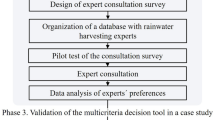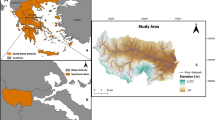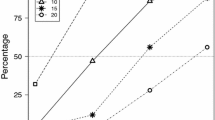Abstract
The traditional data envelopment analysis model allows the decision-making units (DMUs) to evaluate their maximum efficiency values using their most favourable weights. This kind of evaluation with total weight flexibility may prevent the DMUs from being fully ranked and make the evaluation results unacceptable to the DMUs. To solve these problems, first, we introduce the concept of satisfaction degree of a DMU in relation to a common set of weights. Then a common-weight evaluation approach, which contains a max–min model and two algorithms, is proposed based on the satisfaction degrees of the DMUs. The max–min model accompanied by our Algorithm 1 can generate for the DMUs a set of common weights that maximizes the least satisfaction degrees among the DMUs. Furthermore, our Algorithm 2 can ensure that the generated common set of weights is unique and that the final satisfaction degrees of the DMUs constitute a Pareto-optimal solution. All of these factors make the evaluation results more satisfied and acceptable by all the DMUs. Finally, results from the proposed approach are contrasted with those of some previous methods for two published examples: efficiency evaluation of 17 forest districts in Taiwan and R&D project selection.

Similar content being viewed by others
References
Amin GR, Toloo M and Sohrabi B (2006). An improved MCDM DEA model for technology selection. International Journal of Production Research 44(13): 2681–2686.
An Q, Yan H, Wu J and Liang L (2016). Internal resource waste and centralization degree in two-stage systems: An efficiency analysis. Omega 61: 89–99.
Charnes A, Cooper WW and Rhodes E (1978). Measuring the efficiency of decision making units. European Journal of Operational Research 2(4): 429–444.
Charnes A, Cooper, WW, Lewin, AY and Seiford, LM (eds) (1994). Data Envelopment Analysis: Theory, Methodology, and Applications. Kluwer: Boston.
Charnes A and Cooper WW (1962). Programming with the linear fractional functionals. Naval Research Logistics Quarterly 9(3–4): 181–186.
Cook W, Roll Y and Kazakov A (1990). A DEA model for measuring the relative efficiencies of highway maintenance patrols. INFOR 28(2): 113–124.
Cook WD and Seiford LM (2009). Data envelopment analysis (DEA)—Thirty years on. European Journal of Operational Research 192(1): 1–17.
Doyle JR and Green RH (1994). Efficiency and cross-efficiency in DEA: Derivations, meanings and uses. Journal of the Operations Research Society 45(5): 567–578.
Dong Y, Chen Y and Li Y (2014). Efficiency ranking with common set of weights based on data envelopment analysis and satisfaction degree. International Journal of Information and Decision Sciences 6(4): 354–368.
Green RH, Doyle JR and Cook WD (1996). Preference voting and project ranking using DEA and cross-evaluation. European Journal of Operational Research 90(3): 461–472.
Ertugrul Karsak E and Sebnem Ahiska S (2008). Improved common weight MCDM model for technology selection. International Journal of Production Research 46(24): 6933–6944.
Ganley JA and Cubbin SA (1992). Public Sector Efficiency Measurement: Applications of Data Envelopment Analysis. North-Holland: Amsterdam.
Jahanshahloo GR, Zohrehbandian M, Alinezhad A, Naghneh SA, Abbasian H and Mavi RK (2011). Finding common weights based on the DM’s preference information. Journal of the Operational Research Society 62(10): 1796–1800.
Kao C and Yang YC (1992). Reorganization of forest districts via efficiency measurement. European Journal of Operational Research 58(3): 356–362.
Kao C and Hung HT (2005). Data envelopment analysis with common weights: The compromise solution approach. Journal of the Operational Research Society 56(10): 1196–1203.
Li Y, Yang M, Chen Y, Dai Q and Liang L (2013). Allocating a fixed cost based on data envelopment analysis and satisfaction degree. Omega 41(1): 55–60.
Liang L, Wu J, Cook WD and Zhu J (2008). Alternative secondary goals in DEA cross efficiency evaluation. International Journal of Production Economics 113(2): 1025–1030.
Liang L, Wu J, Cook WD and Zhu J (2008a). The DEA game cross-efficiency model and its Nash equilibrium. Operations Research 56(5): 1278–1288.
Liu FHF and Peng HH (2008). Ranking of units on the DEA frontier with common weights. Computers & Operations Research 35(5): 1624–1637.
Lotfi FH, Hatami-Marbini A, Agrell PJ, Aghayi N and Gholami K (2013). Allocating fixed resources and setting targets using a common-weights DEA approach. Computers & Industrial Engineering 64(2): 631–640.
Oral M, Kettani O and Lang P (1991). A methodology for collective evaluation and selection of industrial R&D projects. Management Science 37(7): 871–883.
Qi XG and Guo B (2014). Determining common weights in data envelopment analysis with Shannon’s entropy. Entropy 16(12): 6394–6414.
Roll Y, Cook WD and Golany B (1991). Controlling factor weights in data envelopment analysis. IIE Transactions 23(1): 2–9.
Roll Y and Golany B (1993). Alternate methods of treating factor weights in DEA. Omega 21(1): 99–109.
Saati S, Hatami-Marbini A, Agrell PJ and Tavana M (2012). A common set of weight approach using an ideal decision making unit in data envelopment analysis. Journal of Industrial and Management Optimization 8(3): 623–637.
Sexton TR, Silkman RH and Hogan AJ (1986). Data envelopment analysis: Critique and extensions. In: Silkman RH (ed). Measuring Efficiency: An Assessment of Data Envelopment Analysis. Jossey-Bass: San Francisco, Issue 32 pp 73–105.
Sinuany-Stern Z and Friedman L (1998). DEA and the discriminant analysis of ratios for ranking units. European Journal of Operational Research 111(3): 70–478.
Sun J, Wu J and Guo D (2013). Performance ranking of units considering ideal and anti-ideal DMU with common weights. Applied Mathematical Modelling 37(9): 6301–6310.
Sun J, Wu J, Liang L, Zhong RY and Huang GQ (2014). Allocation of emission permits using DEA: Centralized and individual points of view. International Journal of Production Research 52(2): 419–435.
Wang YM, Chin KS and Leung JPF (2009). A note on the application of the data envelopment analytic hierarchy process for supplier selection. International Journal of Production Research 47(11): 3121–3138.
Wang YM and Chin KS (2010). Some alternative models for DEA cross-efficiency evaluation. International Journal of Production Economics 128(1): 332–338.
Wu J, Sun J, Zha Y and Liang L (2011). Ranking approach of cross-efficiency based on improved TOPSIS technique. Journal of Systems Engineering and Electronics 22(4): 604–608.
Yang F, Yang C, Liang L and Du S (2010). New approach to determine common weights in DEA efficiency evaluation model. Journal of Systems Engineering and Electronics 21(4): 609–615.
Zohrehbandian M, Makui A and Alinezhad A (2010). A compromise solution approach for finding common weights in DEA: An improvement to Kao and Hung’s approach. Journal of the Operational Research Society 61(4): 604–610.
Acknowledgements
The research is supported by National Natural Science Funds of China (No. 71501189, 71222106 and 71571173), Research Fund for the Doctoral Program of Higher Education of China (No.20133402110028), Foundation for the Author of National Excellent Doctoral Dissertation of P.R. China (No. 201279) and Top-Notch Young Talents Program of China.
Author information
Authors and Affiliations
Corresponding author
Rights and permissions
About this article
Cite this article
Wu, J., Chu, J., Zhu, Q. et al. Determining common weights in data envelopment analysis based on the satisfaction degree. J Oper Res Soc 67, 1446–1458 (2016). https://doi.org/10.1057/jors.2016.35
Published:
Issue Date:
DOI: https://doi.org/10.1057/jors.2016.35




